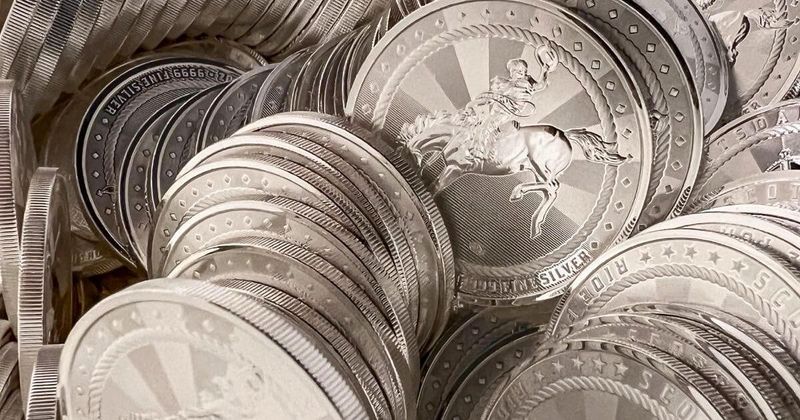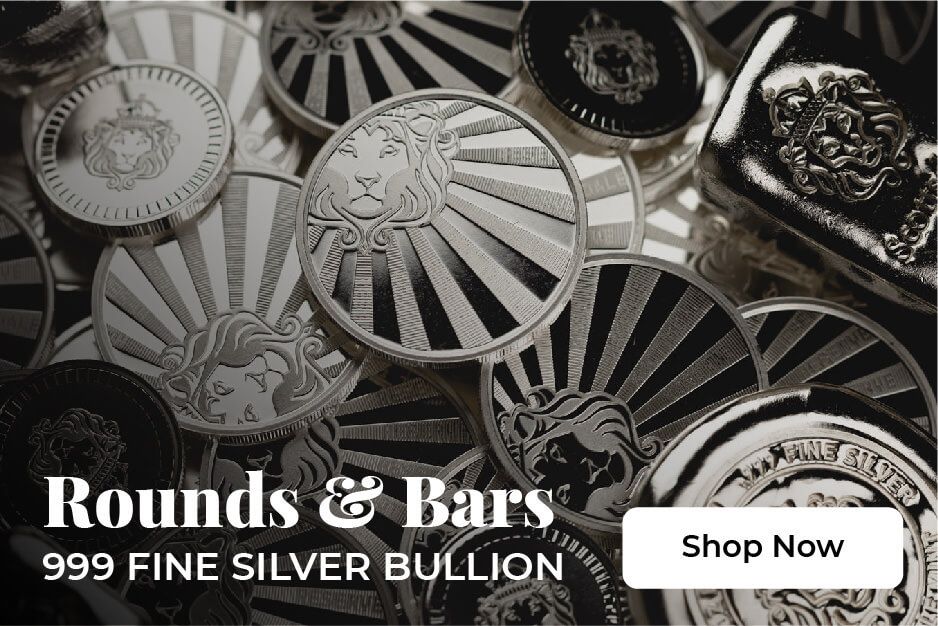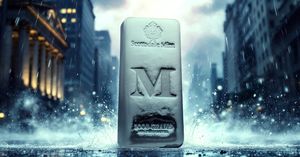There are many reasons people get into collecting silver coins and other types of bullion. For some, it’s as simple as the design of a coin. For others, it’s a way to diversify their portfolio to hedge against inflation.

However, many collect silver bullion (bars, coins, or rounds) as a way to grow and diversify their investments. In recent decades, precious metals have become a popular avenue for the savvy investor, and there are more than a couple reasons to collect silver coins and bullion…
Silver, like gold, is real money – Unlike paper or many digital currencies, silver can’t be created out of thin air. It’s a real asset that you can hold. It has intrinsic value. Take that Jerome Powell.
Silver is relatively cheap (compared to gold) – With the current gold to silver ratio at roughly 88 (right around the historic average), silver has a much lower barrier to entry for acquisition. Gold has its place of course – it carries a lot of value for its weight, so it’s more compact to carry around and store.
Increasing Demand Foreshadows Scarcity – Silver is the second most consumed commodity after oil, and silver’s range of uses is only increasing. With many industrial applications (solar panels, batteries, pharmaceuticals, etc.), and mining and processing costs increasing, it would not be unreasonable to expect shortages or restricted access in the coming years.
With that high level overview in mind – here are some of the most common questions about silver.
What is the silver “spot price”?
An easy way to think about it is “spot price” means the current price silver trades at on an exchange, similar to stock prices. The spot price fluctuates minute by minute, and is influenced by world events, silver supply, demand, etc. This price is listed in the banner at the top of virtually every bullion dealer’s site, and it represents the price per troy once of the metal.
Can you buy at the spot price?
In most cases, no, bullion coins and bars can’t be bought at the spot price by a retail buyer (unless it’s a special promotion!).
This would be like buying a laptop or golf clubs for the cost of the materials. It doesn’t include expenses related to fabrication, packaging, shipping, marketing, trading, insurance, etc.
What does “stacking” mean?
This one’s easy. Just like it sounds, silver “stacking” is the act of building up a stockpile of silver. Whether it be bars, coins, rounds, even silver dinnerware. If it’s made out of silver, there’s bound to be someone who’s stacking it. Do a quick Google or Reddit search, and there are some sweet collections to be seen.
If you are interested in getting a feel for the variety of hallmarks, mints, and bullion formats that exist, looking at other people’s stacks online is a great rabbit hole to go down.
People usually stack silver for a few different reasons: (1) It’s fun and can be addicting, (2) as a hedge against economic downturn, (3) or a little of both.
When getting into silver stacking, consider these best practices:
Things to Do
Create a budget – whether buying weekly, monthly, or bi-monthly, having a budget will keep you on course to reach your stacking goals.
Buy from reputable dealers – with more people than ever buying, there’s even more people trying to make a quick buck. A good rule of thumb is to stay away from deals that seem too good to be true, or are from a suspicious looking source.
Have fun! Holding a 100oz silver bar in your hand for the first time is a rush. Having a pile of them in your safe or vault feels pretty good too.
Things to NOT Do
Go on a silver splurge outside an intended budget. Keep a steady hand on the wheel and don’t get greedy. It’s easy to get emotional with any kind of investing or collecting, but remember your long term goal when there is short term excitement (to both the down or upside!)
Buy from suspect dealers or sources – if it’s a ridiculous deal, it’s probably too good to be true. Generally speaking, steer clear of online marketplace ads, pawn shops, and the like.
Ahhh, there’s nothing like spending a Friday night looking at a cool silver collection. Similar to that scene from Scarface, except your desk is covered in precious metal coins and bars. “Say hello to my silver bars!”
Picture of scarface with a silver and gold stack on his desk
You’ve started stacking, now what?
Let’s talk about storing and taking care of silver.
Should I keep my silver at home?
In most cases, it’s a solid idea to have some silver (and gold) at home, or somewhere that’s easily accessible. If things hit the fan… bank closures, failing electrical grids, a natural disaster – your silver and precious metals will be within reach and ready to take, “Honey, get the van ready!” Burying precious metals in the backyard is probably not the best idea, especially during a time crunch, and let’s not forget about metal detectors. If you do go this route, make sure to store the bullion inside something that will protect it from tarnishing. Although tarnish doesn’t corrode or damage silver in any way, it does take away the shine. Some inventive people have used capped-off PVC pipes to store silver and gold underground.
One advantage bullion offers is that the vast majority of the population sees and understands the value in it, so it can be a lifesaver during an emergency situation. If for whatever reason the value of fiat currency (government-issued money) plummets dramatically, you’ll have your stash of precious metals to barter with.
Why does it matter how silver is stored?

Silver can tarnish over time, which takes away the shine. Silver doesn’t corrode or fall apart when it’s tarnished, as opposed to other non-precious metals like iron or steel, and the tarnish won’t take away from the intrinsic value of the silver itself. But, if you want to make sure your coins and bars stay looking nice over time, you should consider means and method of storage.
This is especially important for numismatic coins, which have value above and beyond the precious metal content. If they get tarnished, the overall resell value may take a hit.
Find a dry and cool place
Humidity and moisture will dramatically accelerate the time it takes for tarnish to accumulate.
A good DIY option is to buy some vacuum seal containers online or at a local store. Keeping like with like (organization is key to easy inventorying of your stack), use soft cotton gloves to place bars or coins in containers, then push down the lid or other sealing mechanism to flush out as much air as possible.
You may even want to go a step further and look for hard plastic coin or bar capsules to individually seal and protect each item. You can also look for flexible plastic bags to use as a secondary layer of storage before placement in the larger vacuum seal container. Make sure whatever you buy is specifically for precious metals or jewelry applications! Many common plastic bags contain chemicals that will actually CAUSE your silver to tarnish.
Another tip: Avoid rubber bands like the plague! The rubber compound will nearly instantaneously cause the silver to tarnish, even through a plastic bag or cloth.
What causes silver to tarnish?

Generally, silver will begin to tarnish when exposed to moisture in the air. There are a number of chemicals that cause silver to tarnish, but the most common culprit is sulfur. When silver reacts with hydrogen sulfide it begins to blacken and tarnish. It may not smell like rotten eggs around you, but sulfur is constantly in our natural environment. Many products such as soaps, cleaners, perfumes, and certain foods contain sulfur compounds.
Handling silver coins, bars, and rounds
The first step in knowing how to clean silver is learning the best handling methods. The best method for keeping silver tarnish free is resisting the urge to pick it up with your bare hands.
Never use latex gloves or tweezers to handle silver. Many times, latex gloves are coated with different powders or lubricants than can damage bullion. Tweezers are somewhat self explanatory – the sharp metal can scuff and scratch the comparatively soft surface of the silver.
So what is the best way to get a closer look at your treasured bullion collection? The best way to handle bullion is with soft cotton gloves. Also, it’s a good idea to keep all the action centered over a surface like a table or workbench that’s been covered with a soft cloth just in case you drop something. Silver is pretty soft (for metal) and will dent and ding easily.
Speaking of dropping – moving bullion around in a controlled manner and at a safe working height is important. You only need to drop a 100oz bar on your foot once to experience instant regret. To add insult to the injury you just sustained, you’ll realize your cherished silver bar or coin just picked up a good sized dent. From your foot.
Cleaning your silver
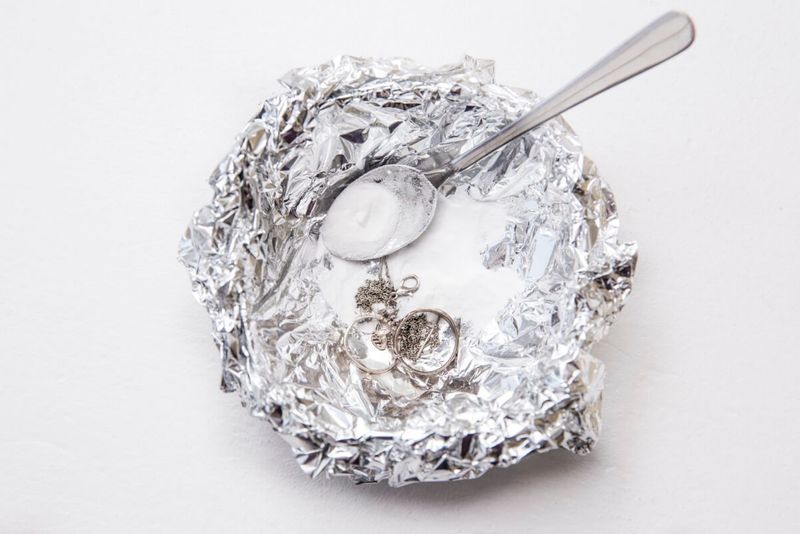
Over time, it’s common to see silver coins and bars beginning to get a slight yellow tinge on the surface, which may turn to light purple before turning black. Do not panic! Luckily, it’s simple to remove tarnish from silver. And remember, tarnish is only cosmetic and doesn’t actually take away from the metal content.
The first question is, is it necessary to clean silver coins or bullion?
This may not come a surprise, but many avid coin collectors prefer the natural tarnish on a coin. It can add a lot of character that only time can bring. If you picked up an older coin, think twice before scrubbing it clean. Some of those dramatic hues could have taken decades or centuries to form, and “bringing it back to life” may actually be taking away the life of a coin.
If you do decide to clean your silver though, the process is easy and makes use of common household ingredients. You can use baking soda, hot water, and aluminum foil to chemically remove the tarnish. It’s a fun at-home science project!
Should I keep my silver coins in plastic?
Coin storage is one of the most common questions. It is recommended that the coins should never be stored in albums, so avoid regular plastic bags or vinyl. Certain plastic & polypropylene containers can release harmful acid vapors that can damage the coins, so be careful.
Two of the best methods for storing bullion are lined wooden boxes and mylar bags – it’s up to personal preference and environment.
The benefits of mylar:
Extremely low oxygen transmission rate – simply put, the less oxygen, the better.
3 Layers of Protection – it’s resistant to light, moisture, and odor (who wants smelly coins, right?)
Durable as heck – it’s also flexible and thin, which makes it easier to cram into tight spaces.
Mylar containers are a great option if you aren’t 100% sure if your precious metals will be exposed to a humid environment. When in a humid area, it’s still not a bad idea to drop in a silica gel to help remove any moisture.
The benefits of a wood box:
Cheap – there could be one sitting at home right now! Line it with anti-tarnish cloth to provide a soft surface, and you’re good to go.
It’s inconspicuous – Using a boring old box does a good job of not attracting too much attention. It’s more or less “hidden in plain sight”.
In areas with low humidity, a wooden box may be the easiest and simplest choice.
Is it safe to keep silver at home?

As mentioned earlier, it’s a great idea to keep some silver bullion at home.
Your biggest risks are theft and natural disasters. It’s important to take these factors into consideration when storing physical bullion at home. Much of the decision making process will depend on the individuals comfort level, how much bullion they want to keep on hand, and available space.
Whether living in an apartment, a suburb, or on 40 acres – here are some factors to consider when it comes to storage methods:
1. Choosing a Safe
When deciding on a safe it’s important to think about the types of metal being stored (silver coins, gold bullion, or any other precious metal) and how much will be allocated to one location. Safes come in a massive range of sizes and prices. For stacking and storing silver bullion, a larger safe is recommended so that there are no space constraints. For example, $50,000 worth of pure gold can be held in one hand, but a sturdy wheelbarrow would be needed for the same value of silver.
If given the option, use a safe that is airtight and waterproof – there’s less room for error.
The larger the better?
Smaller safes are cheaper, but the drawbacks have much to do with the weight. If it’s less than a couple hundred pounds, thieves can “easily” (they’ll find a way to) dolly it out of there. Another downside is the possibility of running out of space when using it to store silver bullion.
A bigger and heavier floor safe safe will offer a lot more storage space for storing silver bars. Not to get on the paranoid side, but take into consideration that if someone helps move a safe then they’ll have an idea that there’s bullion at home. On the upside, it’ll take quite a bit of collecting before running out of silver coin storage.
2. Be Creative With Your Hiding Spot
Here comes the fun part! This is where thinking like a thief comes in handy.
Keep in mind: any tips you read about keeping bullion hidden may or may not be good ones. Thieves have the internet too.
Nearly everyone has read about keeping their safe hidden under a china cabinet. That’s been repeated so many times, so take it as advice not to do so. Closets are pretty common areas, as well as basements, so think outside the box.
If using a smaller container, rather than safe, the possibilities are endless. This is where being handy/creative has the advantage – go full Sherlock Holmes and make a neat removable brick in the fireplace or something of the sorts.
Here’s what’s most important: don’t hide it from yourself.
3. No One Needs to Know
Keep it on the down low. Gold and silver are one of the few financial assets that most everyone understands the value of, and it’s much more visually enticing than gold jewelry. This may seem obvious, but gold coins and silver bars belong in home storage, not on Instagram.
It’s surprising how much people will share online, and it can open them up to unknown danger. Don’t let the internet be the digital window into your home. If you do share pictures online, make sure you do it anonymously and scrape geo locations from your phone pictures before sharing.
It’s beneficial for at least one person to know about the home storage situation (and how to get in), possibly a spouse or an older child. In the case of an emergency or natural disaster, someone needs to access.
But What About Insurance?
Yes, good point. Is all that metal sitting in your house insured in the event of a fire, theft, or other disaster? The answer is maybe, but probably not. Check your homeowner’s or renter’s insurance policy for details, but due to the value and nature of bullion, it likely won’t be insured for the full value unless you have a special rider or endorsement on your policy.
Using Third-Party Storage for Silver Bullion
Self Storage Facilities
Generally, it is strongly recommended to not use typical self-storage facilities. While it may seem economical, they have major security issues. Employees who work at self-storage facilities have less scrutiny than bank employees and often use stolen property for quick profits. Even the most effective locks can be picked; most security measures at these facilities are more for display than actual deterrence.
Using a self storage unit is the equivalent of keeping someone’s livelihood locked up at a motel across town.
It’s basically the same thing, except the motel happens to include a bed and Denny’s across the street.
Professional Vault Service
This is a much better and safer option than a self storage facility. With dedicated security and optimal storage arrangements, it’ll be easy to catch a good night’s rest.
Need help choosing a vault?
At Scottsdale Mint, we provide unbiased educational materials that not only help you choose the vaulting option that best fits your situation, but exceeds your needs for risk mitigation. If this seems like a good fit for you, you can easily get a custom quote.
Using Banks as Storage
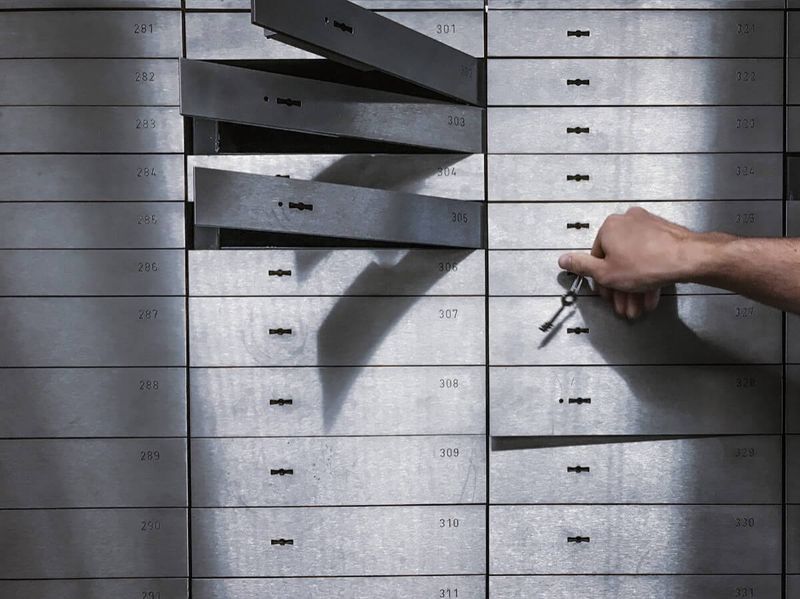
Banks commonly offer safe deposit boxes for rent to their customers. Many precious metal investors consider using a safe deposit box to store silver coins, and it makes sense, that’s where a majority of your money is stored – so why not use it for your bullion too?
Safe deposit boxes, being in a bank, are intended to provide greater security than a home safe and are almost as accessible for quick withdrawals.
However, there are drawbacks with a safe deposit box…
Accessibility – this is a plus during normal banking hours, but not so much after hours. What if there’s a crisis during a national holiday? Unfortunately, everyone with an account or deposit box is out of luck. Or how about a lockdown?
Minimal Insurance – since it’s not a deposit account, and rather a storage space, the contents are not FDIC-insured.
Freezable Assets – Banks are subject to federal and state laws, therefore, the IRS and government have the authority to seize any deposit box without consent. Bye bye silver bars.
Vulnerable to Crashes – What if there’s a financial crisis or an environmental disaster, and everyone is scrambling to the bank? It may be dangerous and potentially life-threatening to try to access or secure silver kept in a bank safe deposit box.
Deciding whether to use a bank to store coins comes down to personal reasons for purchasing precious metals in the first place. Looking for security and quick access? A bank may be a good fit. Not a fan of traditional banking practices? Consider a different avenue.
Final Thoughts
Now that you’ve begun to consider how to store, handle, clean, and protect your silver – it’s time to start purchasing some bullion of your own, or adding to your stack(s).
For those coming into precious metals from an investment perspective, then the silver stackers are a great place to start. Scottsdale Mint offers both coins and bars, depending on your preference. Each has a sleek design and they interlock with one another to make for maximum use of space. Otherwise, if you are like most collectors who like a mix of everything, then go crazy!
Thank you for reading, and happy stacking!
